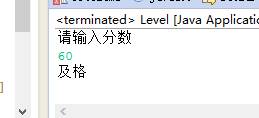一.请阅读并运行AboutException.java示例,然后通过后面的几页PPT了解Java中实现异常处理的基础知识。
1.代码:
import javax.swing.*;
class AboutException {
public static void main(String[] a)
{
int i=1, j=0, k;
k=i/j;
try
{
k = i/j; // Causes division-by-zero exception
//throw new Exception("Hello.Exception!");
}
catch ( ArithmeticException e)
{
System.out.println("被0除. "+ e.getMessage());
}
catch (Exception e)
{
if (e instanceof ArithmeticException)
System.out.println("被0除");
else
{
System.out.println(e.getMessage());
}
}
finally
{
JOptionPane.showConfirmDialog(null,"OK");
}
}
}
2.结果截图:

3. 异常处理的基础知识:
Try{
//可能发生运行错误的代码;
}
catch(异常类型 异常对象引用){
//用于处理异常的代码
}
finally{
//用于“善后” 的代码
}
处理机制:把可能会发生错误的代码放进try语句块中。当程序检测到出现了一个错误时会抛出一个异常对象。异常处理代码会捕获并处理这个错误。catch语句块中的代码用于处理错误。当异常发生时,程序控制流程由try语句块跳转到catch语句块。不管是否有异常发生,finally语句块中的语句始终保证被执行。如果没有提供合适的异常处理代码,JVM将会结束掉整个应用程序。
二. 阅读以下代码(CatchWho.java),写出程序运行结果:
1.代码:
public class CatchWho {
public static void main(String[] args) {
try {
try {
throw new ArrayIndexOutOfBoundsException();
}
catch(ArrayIndexOutOfBoundsException e) {
System.out.println( "ArrayIndexOutOfBoundsException" + "/内层try-catch");
}
throw new ArithmeticException();
}
catch(ArithmeticException e) {
System.out.println("发生ArithmeticException");
}
catch(ArrayIndexOutOfBoundsException e) {
System.out.println( "ArrayIndexOutOfBoundsException" + "/外层try-catch");
}
}
}
2.结果截图:

3.结果分析:内层捕捉异常结果并处理后,外层则不再捕捉该异常。
三.写出CatchWho2.java程序运行的结果
1.代码:
public class CatchWho2 {
public static void main(String[] args) {
try {
try {
throw new ArrayIndexOutOfBoundsException();
}
catch(ArithmeticException e) {
System.out.println( "ArrayIndexOutOfBoundsException" + "/内层try-catch");
}
throw new ArithmeticException();
}
catch(ArithmeticException e) {
System.out.println("发生ArithmeticException");
}
catch(ArrayIndexOutOfBoundsException e) {
System.out.println( "ArrayIndexOutOfBoundsException" + "/外层try-catch");
}
}
}
2.结果截图:
3.结果分析:当异常没有被处理时,无法捕获并处理新异常
四.请先阅读 EmbedFinally.java示例,再运行它,观察其输出并进行总结。
1.代码:
public class EmbededFinally {
public static void main(String args[]) {
int result;
try {
System.out.println("in Level 1");
try {
System.out.println("in Level 2");
// result=100/0; //Level 2
try {
System.out.println("in Level 3");
result=100/0; //Level 3
}
catch (Exception e) {
System.out.println("Level 3:" + e.getClass().toString());
}
finally {
System.out.println("In Level 3 finally");
}
// result=100/0; //Level 2
}
catch (Exception e) {
System.out.println("Level 2:" + e.getClass().toString());
}
finally {
System.out.println("In Level 2 finally");
}
// result = 100 / 0; //level 1
}
catch (Exception e) {
System.out.println("Level 1:" + e.getClass().toString());
}
finally {
System.out.println("In Level 1 finally");
}
}
}
2.结果截图:
3.结果分析:一抛一接,抛之后必须有一接。当有多层嵌套的finally时,异常在不同的层次抛出,在不同的位置抛出,可能会导致不同的finally语句块执行顺序。
五. finally语句块一定会执行吗?请通过 SystemExitAndFinally.java示例程序回答上述问题
1.代码:
public class SystemExitAndFinally {
public static void main(String[] args)
{
try{
System.out.println("in main");
throw new Exception("Exception is thrown in main");
//System.exit(0);
}
catch(Exception e)
{
System.out.println(e.getMessage());
System.exit(0);
}
finally
{
System.out.println("in finally");
}
}
}
2.结果截图:
3.改后代码:
public class SystemExitAndFinally {
public static void main(String[] args)
{
try{
System.out.println("in main");
throw new Exception("Exception is thrown in main");
//System.exit(0);
}
catch(Exception e)
{
System.out.println(e.getMessage());
//System.exit(0);
}
finally
{
System.out.println("in finally");
}
}
}
4.结果截图:
5.结果分析:当try语句执行时,对应的finally语句会执行。当没有写入让系统执行退出的命令时,fanlly会执行。
六. 请看以下代码,它们完全符合Java语法规范,但事实是它们不能通过编译
1.代码:
public class TestThrows {
public static void main(String[] args) {
FileInputStreamfis=new FileInputStream("a.txt");
}
} 不能通过编译
2.修正后的代码:
public class TestThrows
{
public static void main(String[] args)
throws FileNotFoundException
{
FileInputStream fis = new FileInputStream("a.txt");
}
}
修正之后通过编译
3.原因:throws语句表明某方法中可能出现某种(或多种)异常,但它自己不能处理这些异常,而需要由调用者来处理。当一个方法包含throws子句时,需要在调用此方法的代码中使用try/catch/finally进行捕获,或者是重新对其进行声明,否则编译时报错。throws语句中声明的异常称为受控(checked)的异常,通常直接派生自Exception类。
七.编写一个程序,此程序在运行时要求用户输入一个整数,代表某门课的考试成绩,程序接着给出“不及格”、“及格”、“中”、“良”、“优”的结论
1.代码:
import java.util.*;
class NumberError extends Exception
{
NumberError(String a)
{
super(a);
}
}
class NumberBeyond extends Exception
{
NumberBeyond(String b)
{
super(b);
}
}
public class Level {
/**
* @param args
*/
public static void Numbererror() throws NumberError
{
throw new NumberError("");
}
public static void Numberbeyond()throws NumberBeyond
{
throw new NumberBeyond("");
}
public static void main(String[] args) {
// TODO Auto-generated method stub
Scanner input=new Scanner(System.in);
System.out.println("请输入分数");
String in=input.next();
int y=1;
try
{
for(int i=0;i<in.length();i++)
{
if((in.charAt(i)>'9'||in.charAt(i)<0)&&in.charAt(i)!='.')
{
Level.Numbererror();
}
}
try
{
double x=Double.parseDouble(in);
if(x>100.0||x<0.0)
{
Level.Numberbeyond();
y=0;
}
if(x>0.0&&x<60.0&&y==1)
{
System.out.println("不及格");
}
if(x>=60.0&&x<70.0&&y==1)
{
System.out.println("及格");
}
if(x>=70.0&&x<80.0&&y==1)
{
System.out.println("中");
}
if(x>=80&&x<90&&y==1)
{
System.out.println("良");
}
if(x>=90&&x<=100&&y==1)
{
System.out.println("优");
}
}
catch(NumberBeyond e)
{
System.out.println("输入超出范围"+e);
}
}
catch (NumberError e)
{
System.out.println("应该输入数字"+e);
}
}
}
2.结果截图:

